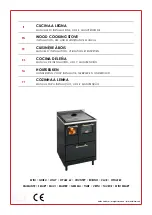
20
4
4
F
F
A
A
U
U
L
L
T
T
F
F
I
I
N
N
D
D
I
I
N
N
G
G
To assist with servicing and fault finding we categorise problems under the
headings listed.
1
1
.
.
F
F
U
U
E
E
L
L
S
S
U
U
P
P
P
P
L
L
Y
Y
P
P
R
R
O
O
B
B
L
L
E
E
M
M
S
S
(See Pre Amble notes)
1. Fuel contamination problems
2. Fuel type and quality problems
3. Fuel feed problems
2
2
.
.
A
A
I
I
R
R
S
S
U
U
P
P
P
P
L
L
Y
Y
P
P
R
R
O
O
B
B
L
L
E
E
M
M
S
S
Air is drawn into the burner by the action of the chimney.
THE POWER, (suck or vacuum the chimney can develop) depends upon the
following-:
THE HEIGHT.
THE DIAMETER.
THE TEMPERATURE OF THE GASSES IN IT.
THE RESISTANCE OF THE INNER SURFACE OF THE FLUE PIPE OR PIPES.
On a boat all the above elements are in short supply.
Normally, we have to deal with low flues which are small in diameter and
generally not very well insulated, coupled with all these problems we have an
other one, which is that the boat moves across constantly changing surroundings,
through locks, into headwinds and crosswinds, all creating major opportunity for
down draughting to occur.
Any bend in any part of the chimney or roughness on the internal chimney wall
will slow down the velocity of rising gases and reduce the effectiveness of the
chimney.
Any slight reduction in the flue gas temperature will reduce the chimney vacuum
or pull, hence when the stove is slowed down for all night burning, as the flue gas
cools down the chimney vacuum reduces and as the chimney vacuum drops, the
stove may well start to burn sooty.
This problem is highlighted even more during very cold weather when the
chimney can cool down even faster.
THE CHIMNEY RULES.
Always use a top outlet for flue pipe take off.
Never put any bends in the flue. (To maintain a concentric fit, we will allow a
slight kick off the stove and a similar kick into the deck flange).








































